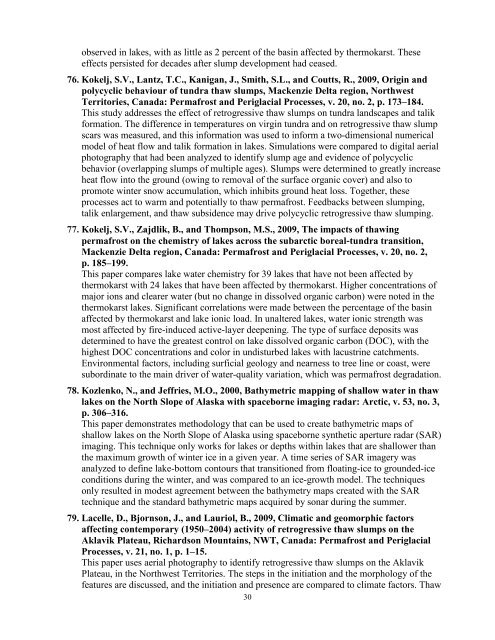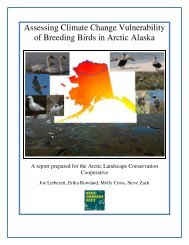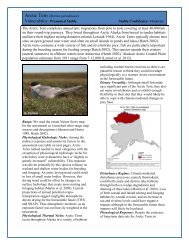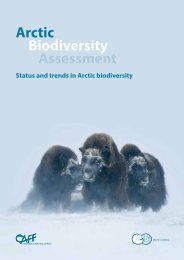Permafrost Terrain Stability and Thermokarst Monitoring: - Arctic LCC
Permafrost Terrain Stability and Thermokarst Monitoring: - Arctic LCC
Permafrost Terrain Stability and Thermokarst Monitoring: - Arctic LCC
Create successful ePaper yourself
Turn your PDF publications into a flip-book with our unique Google optimized e-Paper software.
observed in lakes, with as little as 2 percent of the basin affected by thermokarst. These<br />
effects persisted for decades after slump development had ceased.<br />
76. Kokelj, S.V., Lantz, T.C., Kanigan, J., Smith, S.L., <strong>and</strong> Coutts, R., 2009, Origin <strong>and</strong><br />
polycyclic behaviour of tundra thaw slumps, Mackenzie Delta region, Northwest<br />
Territories, Canada: <strong>Permafrost</strong> <strong>and</strong> Periglacial Processes, v. 20, no. 2, p. 173–184.<br />
This study addresses the effect of retrogressive thaw slumps on tundra l<strong>and</strong>scapes <strong>and</strong> talik<br />
formation. The difference in temperatures on virgin tundra <strong>and</strong> on retrogressive thaw slump<br />
scars was measured, <strong>and</strong> this information was used to inform a two-dimensional numerical<br />
model of heat flow <strong>and</strong> talik formation in lakes. Simulations were compared to digital aerial<br />
photography that had been analyzed to identify slump age <strong>and</strong> evidence of polycyclic<br />
behavior (overlapping slumps of multiple ages). Slumps were determined to greatly increase<br />
heat flow into the ground (owing to removal of the surface organic cover) <strong>and</strong> also to<br />
promote winter snow accumulation, which inhibits ground heat loss. Together, these<br />
processes act to warm <strong>and</strong> potentially to thaw permafrost. Feedbacks between slumping,<br />
talik enlargement, <strong>and</strong> thaw subsidence may drive polycyclic retrogressive thaw slumping.<br />
77. Kokelj, S.V., Zajdlik, B., <strong>and</strong> Thompson, M.S., 2009, The impacts of thawing<br />
permafrost on the chemistry of lakes across the subarctic boreal‐tundra transition,<br />
Mackenzie Delta region, Canada: <strong>Permafrost</strong> <strong>and</strong> Periglacial Processes, v. 20, no. 2,<br />
p. 185–199.<br />
This paper compares lake water chemistry for 39 lakes that have not been affected by<br />
thermokarst with 24 lakes that have been affected by thermokarst. Higher concentrations of<br />
major ions <strong>and</strong> clearer water (but no change in dissolved organic carbon) were noted in the<br />
thermokarst lakes. Significant correlations were made between the percentage of the basin<br />
affected by thermokarst <strong>and</strong> lake ionic load. In unaltered lakes, water ionic strength was<br />
most affected by fire-induced active-layer deepening. The type of surface deposits was<br />
determined to have the greatest control on lake dissolved organic carbon (DOC), with the<br />
highest DOC concentrations <strong>and</strong> color in undisturbed lakes with lacustrine catchments.<br />
Environmental factors, including surficial geology <strong>and</strong> nearness to tree line or coast, were<br />
subordinate to the main driver of water-quality variation, which was permafrost degradation.<br />
78. Kozlenko, N., <strong>and</strong> Jeffries, M.O., 2000, Bathymetric mapping of shallow water in thaw<br />
lakes on the North Slope of Alaska with spaceborne imaging radar: <strong>Arctic</strong>, v. 53, no. 3,<br />
p. 306–316.<br />
This paper demonstrates methodology that can be used to create bathymetric maps of<br />
shallow lakes on the North Slope of Alaska using spaceborne synthetic aperture radar (SAR)<br />
imaging. This technique only works for lakes or depths within lakes that are shallower than<br />
the maximum growth of winter ice in a given year. A time series of SAR imagery was<br />
analyzed to define lake-bottom contours that transitioned from floating-ice to grounded-ice<br />
conditions during the winter, <strong>and</strong> was compared to an ice-growth model. The techniques<br />
only resulted in modest agreement between the bathymetry maps created with the SAR<br />
technique <strong>and</strong> the st<strong>and</strong>ard bathymetric maps acquired by sonar during the summer.<br />
79. Lacelle, D., Bjornson, J., <strong>and</strong> Lauriol, B., 2009, Climatic <strong>and</strong> geomorphic factors<br />
affecting contemporary (1950–2004) activity of retrogressive thaw slumps on the<br />
Aklavik Plateau, Richardson Mountains, NWT, Canada: <strong>Permafrost</strong> <strong>and</strong> Periglacial<br />
Processes, v. 21, no. 1, p. 1–15.<br />
This paper uses aerial photography to identify retrogressive thaw slumps on the Aklavik<br />
Plateau, in the Northwest Territories. The steps in the initiation <strong>and</strong> the morphology of the<br />
features are discussed, <strong>and</strong> the initiation <strong>and</strong> presence are compared to climate factors. Thaw<br />
30








